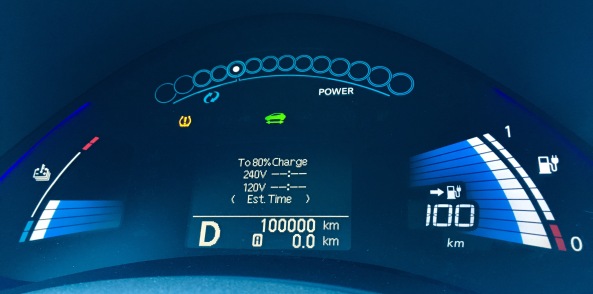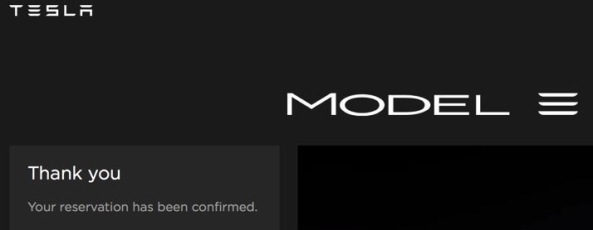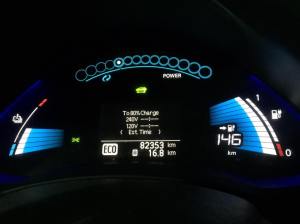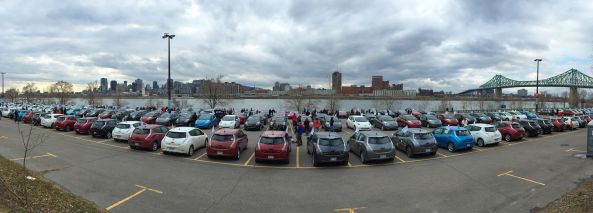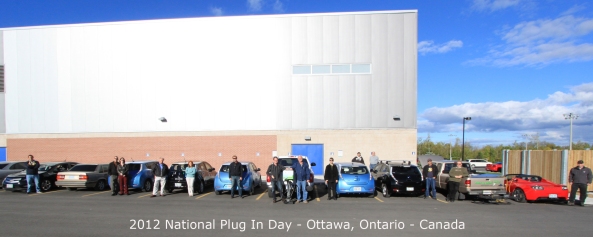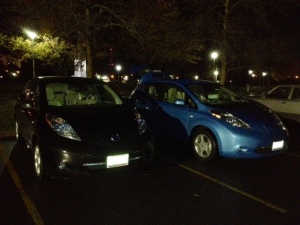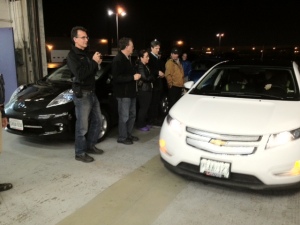
Driving the Nissan LEAF in the city is a no-brainer in terms of range. We rarely need to drive more than what the LEAF can go on a full charge, and we’re always relatively close to places where we can recharge during the day (home, work, even the dealer). But on road trips, this scenario changes significantly.
I recently had to drive to Ogdensburg, NY in order to pick up a set of snow tires. Not that we can’t find snow tires in Canada — we certainly can, but for some strange reason, tire manufacturers impose much higher prices north of the border so buying the same tires in the US can save us several hundred dollars (about $300 in my case).
A round trip from Ottawa to Ogdensburg is about 165 Km, which is right at the limit of the advertised range of the LEAF, so the trip would have to be very well planned.
On a side note, I did have the option to drive our “range extender” (my wife’s car) instead of the LEAF on this trip, but that would take away all the fun, wouldn’t it?
Dry runs

The Ottawa-Ogdensburg route
There’s a 75 Km highway connecting Ottawa to the US border called the 416. That would be the obvious choice if I was driving a gas-powered car, but driving an electric car at highway speeds significantly reduces the total range. I decided to take LEAF for a spin at the 416 to see how much that would be, and these were the results:
Highway Test:
– Cruise control set to 90 km/h
– 14C, dry road, windy
– Climate control off
– 100.3 Km driven (11 Km/bar)
– Ended with 3 bars left (31/35 Km)
– Estimated total range: 133 Km
Obviously, that wouldn’t be enough for a round trip to Ogdensburg, but the result falls very closely to what the Nissan LEAF Range Chart predicts.
According to the range chart, I would need to lower the target speed down to 70 Km/h in order to achieve a safe 177 Km range. However, this range estimate assumes an outside temperature of 20C, which is quite rare around here in November! Lower temperature means I would have to lower the speed even more, so it became clear that taking the highway would not be a practical option.

The Spencerville Mill, in Spencerville, ON, was my 62 Km checkpoint
With the highway out of the picture, the next step was to find a good route over country roads. Luckily, there are a lot of quiet and well paved roads that can take me to the same destination. These roads are quite pleasant actually, going through small towns like Spencerville, ON and beautiful farms.
Country road test:
– Max speed 65 Km/h, down to 40-50 Km/h in city areas
– 9C, dry road, no wind
– Climate control off
– 124.5 Km driven (13.8 Km/bar)
– Ended with 3 bars left (44 Km)
– Estimated total range: 168 Km
At this pace, I would be able to go all the way to my destination and back on a single charge. In addition, the place where I was buying the tires from (Bill’s Tire) would let me trickle charge while in there, and even a bit longer if I needed to. This would give me some comfort room. I also contacted a friend who lives in Kemptville, right on the route and 40 Km from my house, in case things didn’t work as planned and I needed to make an emergency stop for a recharge at his house.
One final factor to consider was the extra weight of the tires I would be bringing home. I would also be riding on snow tires, which have more rolling resistance than the original Ecopia tires. I didn’t have any data to estimate the impact on performance. The extra weight would add 2.5% to the weight of the car, but the snow tires I would be buying were also low rolling resistance tires. I assumed the drop in performance to be within the margin of error of my estimates, and that I could compensate by monitoring performance and adjusting my speed accordingly on my way back home.
First attempt

I started the drive to Ogdensburg on a Saturday morning. I woke up early and started on the same route I had done previously. Only that this time, conditions were quite different. Early in the morning, the temperature was -7C. Yes, negative 7. I lost the first bar very quickly, with less than 10 Km. Reducing the speed didn’t help as the second bar went out fast too. After 50 Km, my average was 10 Km /bar. I figured at that pace, I would get to my destination with only 4 bars left, and require at least 4 hours of trickle charging to get me back home. So, it was tough decision to make, but I had to turn back and try another day.
Failed attempt:
– Max speed 60 Km/h, lowered to 40-50 Km/h
– -7C, dry road, no wind
– Climate control off
– 99.5 Km driven (10 Km/bar)
– Ended with 2 bars left (38 Km)
– Estimated total range: 138 Km
Second attempt
The weather forecast was calling for much better weather during the week. Wednesday was promising a high of 15C so I planned to leave work early and head to Ogdensburg, taking advantage of the higher temperature. Leaving from work would only add 4-5 Km to the round trip, and thanks to IBM, I was able to top off the batteries back to fully charged at the parking garage before I left.

Charging while changing tires
The trip to Ogdensburg took 86.3 Km and arrived there with 6 bars left. That was about 14 Km/bar, which was really really good. The estimated range left was 95 Km, and I needed only 82 Km to get home. To be extra-safe, I asked the guys at Bill’s Tire to plug in my Level One charger as soon as they parked the LEAF in one of their service bays. They had absolute no problem with that. The service only took 30 minutes — the tires were already mounted on the rims when I arrived, but they let me continue the charge until I got at least 10 Km of extra range for safety. I ended up plugging in for 70 minutes which raised my estimated range from 95 to 106 Km.
With the snow tires on and the original tires tucked away in plastic bags over the folded back seats, I was ready to head back home. Over the border, I had to stop at customs to declare the purchase and pay the Canadian sales tax (13% HST). Tires made in North America are duty free.
Once on Canadian roads, I started to monitor the car performance. Driving at 65 Km/h, I was averaging 13 Km/bar, which was good. I drove through Kemptville, where my friend lives, with about 60 Km of estimated range, and I needed 40 Km to get home. I didn’t see the need to stop for an emergency charge so I stayed on course.
At this point, range anxiety turned into temperature anxiety. With the sun about to set, the temperature outside started to drop quickly. First 14C, then 13C, now it was 12C. For safety, I changed to a quieter back road that allowed me to reduce the speed to 40 Km/h for about 17 Km, while also shortening the distance that I still had to get through.
The final 12 Km were fairly easy, even though I had to go on regular 80 Km/h roads with only one bar left. The “guessometer” was estimating a range of 29 Km so I could safely raise the speed to 65-70 Km/h without any problems. When the estimated range dropped to 20 Km, the last bar started to blink and the center display changed to “battery level is low”. Fortunately, I was only 5 Km from home. I arrived there safely with 15 Km of range to spare.

Back at home with 15 Km to spare.
Final report:
– Max speed 65 Km/h, down to 40-50 Km/h in city areas, 40 Km/h for 17 Km.
– 15C, dry road, no wind
– Climate control off
– 166 Km driven
– 1:10h level-one charge (extra ~10 Km)
– Ended with 1 bar left, low battery alarm, 15 Km range
– Estimated total range, without the level one charge: 171 Km

LEAF on snow tires
Additional notes:
– Back at home, recharging from less than 10% to 80% took exactly 4 hours. I know for a fact that charging from 80 to 100% takes 1.5 hours, which brings the total to 5.5 hours. I really don’t know where the advertised 7 hours recharge time comes from.
– The tires I got were the Michelin X-ICE XI2 205/55R16.
– The name of the tire store is Bill’s Tire Center, 1000 Patterson St, Ogdensburg, NY (315) 393-7660. Great people and great service. Cost per tire was $133, $50 rims, $10 installation, plus a $2.50 waste tire mgmt fee. Total with taxes: US$836.04. Same service in Ottawa would cost C$1150 + HST.
– I didn’t install tire pressure sensors inside the snow tires so now I get this yellow alarm on the display. Not sure if there’s a way to disable the alarm. A set of pressure sensors costs $290 at the dealer. Maybe I’ll get some next winter.
– Crossing into the US, I got a *lot* of questions. Not about me, but about the car!
